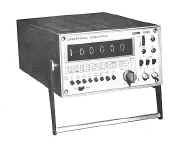| Racal Frequency Counter
Type 835 The 835 Universal Counter is a lightweight compact instrument for
use in laboratory and workshop.
It is designed to facilitate mainly the measurement of frequency, ratio, period average, single and double line time interval and totalize.
To operate over a wide a.c. supply range, of low power requirements and to give maximum accuracy over the whole of the operational temperature range.
The instrument employs solid-state techniques throughout, being hybrid in construction in that it incorporates digital and linear integrated circuit modules with discrete transistors.
The majority of components are mounted on plug-in printed circuit boards.
The polaroid screened display is a sit digit in-line system of cold
cathode numerical indicators with a decimal point, this being
positioned according to the scale and function selected.
The display time is variable and the instrument incorporates a “sample and hold” system.
Two signal inputs are provided: A channel and B channel, these being available as two front panel mounted b.n. c. sockets.
Both these channels have positive / negative trigger slope selection for providing the choice of trigger edge.
The instrument incorporates a high stability oven-controlled crystal standard as an integral part, a buffered output waveform of this internal standard frequency is available at a b. n. c. socket at the rear of the instrument.
An external standard may be fed into this
same socket if required, bearing in mind that the accuracy of the standard used will have a direct bearing on the precision of timing and frequency measurements.
The time -base is manually variable over seven decades, a buffered and gated output waveform of the selected time-base is available at a further b. n. c. socket at the rear of the instrument for external synchronizing purposes.
Optional binary-coded decimal outputs may be added to provide
data for external devices, such as data logging, print-out and
remote display equipment. These outputs are available at a 50-way socket mounted at the rear of the instrument.
|

|


